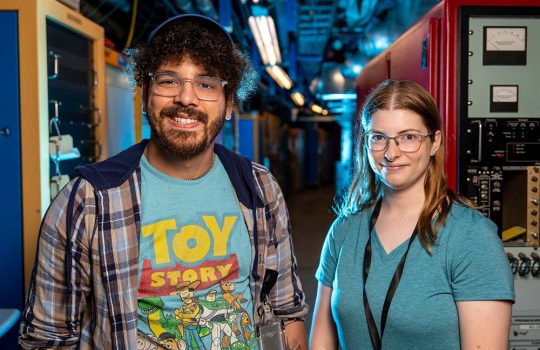BATAVIA, Illinois – The Grid, a global network of computational power with a potential some have likened to that of the Internet, is coming to the classroom. At the Needs Assessment & Developers Workshop for Grid Techniques in Introductory Physics Classroom Projects, held at Florida International University on January 28 and 29, educators, researchers, and scientists met to discuss how students of introductory physics might tap into real physics data sets around the world and collaborate on its analysis over the Internet.
Marge Bardeen, a workshop organizer and the head of the Education Office at the Department of Energy’s Fermilab, said: “It’s important to understand teachers’ needs. What are the opportunities and limitations? It’s nice to be doing this Grid workshop now, because it helps when everybody gets in on the ground floor.”
The workshop was sponsored by CHEPRO, the Center for High Energy Physics Research & Education Outreach; the Computing Division at the Fermi National Accelerator Laboratory; the United States Compact Muon Solenoid Collaboration; and the Education & Outreach Center run by GriPhyN, the Grid Physics Network, and iVDGL, the international Virtual Data Grid Laboratory.
The Grid concept comes from the electricity grid. Grid developers picture a world where people can plug into the network and use as much computation as they need, just like with electricity. Users around the world will share their computational power, data storage capabilities and scientific instruments as if they formed one large computer. As the standards and technology develop, educators hope to tap into the system and harness its capabilities for their students.
During the workshop, teachers of introductory physics discussed how Grid tools and techniques could meet the instructional needs of their classrooms. The coordinators gathered recommendations for project characteristics that would help teachers to integrate such projects into their courses. They also discussed whether additional computer resources at schools and colleges would be required to support these projects and the level of programming skill and interest of students.
Developers of Grid applications then analyzed the results of the teachers’ needs assessment and drafted guidelines for developing a common environment for Grid education projects. They also outlined roles that undergraduate and high school students might play in developing code for these projects.
Many groups with an interest and stake in developing educational and outreach components for their experiments or Grid projects already have such efforts under way. One project at Fermilab allows students to use Fermilab data to calculate the mass of the top quark. The potential for Grid tools and techniques to affect introductory physics education efforts is significant, by providing shared analysis tools, data and results, and to support improved peer-to-peer collaboration. Building quality Grid resources for introductory physics students and teachers strengthens the case for further development of the Grid infrastructure.
“This grass-roots effort, built collaboratively from shared resources and tools, allows us to construct something greater than any single project could accomplish in isolation,” workshop coordinator Ed Moyer of the Illinois Mathematics and Science Academy said. “By taking the lead in this collaboration, we shape what the Grid could become.”
Fermilab is a national laboratory funded by the Office of Science of the U.S. Department of Energy, and operated by Universities Research Association, Inc.



